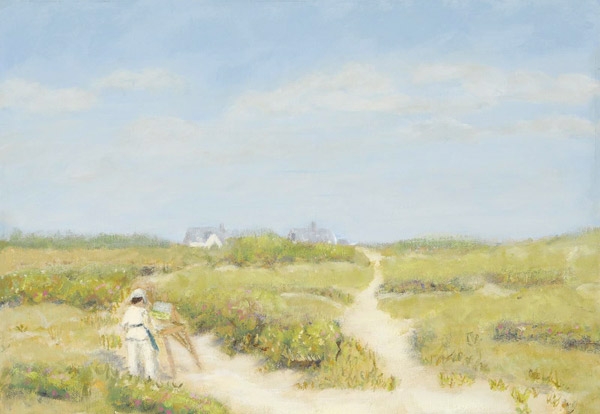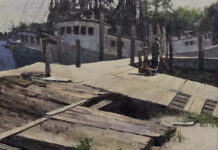
In very few places are the stakes as high in land conservation as they are in the Hamptons. Reports of one acre of “buildable” oceanfront land selling for $16 million exemplify what the Peconic Land Trust is up against on New York’s Long Island. Enter the local artists….
The cooperation of South Shore painters and the Peconic Land Trust dates back more than 10 years, when Rebecca Chapman, the vice president of the Peconic Land Trust, attended the openings of a couple of exhibitions by plein air painter Gordon Matheson. “She said, ‘You ought to put something together to help the Peconic Land Trust, because your paintings show the lands we are conserving’,” recalls Matheson. The artist did exactly that, donating part of the proceeds of a few of his shows to the trust before forming a group of artists in 2006 to tackle the task together. The result was Plein Air Peconic, and a fruitful relationship between an effective conservation group and this dedicated group of painters.

Casey Anderson and Michele Margit paint at Scallop Pond, in North Sea, New York.
“We think it’s really important to showcase and raise awareness for conservation but also support the artist who is capturing the beauty of the landscape that has been preserved,” says the trust’s Chapman. “It’s about the artist, too, and that is very important.” Matheson agrees that the Peconic Land Trust has shown that it values the artists’ work. “We have two different motives, to sell paintings and to preserve the landscape,” Matheson says. “Rebecca is very much of the same mind — she says, ‘We want to help you guys as much as you help us.'”
Chapman says the painters have raised at least $30,000 for the Peconic Land Trust, which she considers a sizable amount. The trust has preserved more than 11,000 acres of land thus far in the east end of Long Island, and when Chapman spoke with us the trust was in the process of trying to match the Town of Easthampton’s pledge of $3.5 million toward the purchase of a $7 million tract of land. But the paintings do more than raise money — they raise awareness. And a land trust has to be very careful where its money goes to make sure people feel like their donations are actually going to preserving land. It’s hard to say how far that $30,000 can take an organization, but actions speak loudly. Peconic Land Trust might not spend its energy on these shows and joint ventures with the Plein Air Peconic if it didn’t make financial sense.

“Scallop Pond Grey Day,” by Casey Anderson, oil, 11 x 14 in.
Chapman says the artists donate 10 percent of their sales. The shows offer painters access to wealthy donors to the land trust, and the trust gains access to wealthy collectors of the artists’ work.
Because the Hamptons area is so desirable, there’s enormous pressure to develop the land. However, unusual alliances have formed to counter this. Both the area farmers and wealthy residents are keenly interested in keeping over-development in check. The truth is that no one moves to an area or buys property in a picturesque place with the idea that development will drastically change its look. Matheson points people to Google Earth as a way of illustrating the changes in the Hamptons. That online feature allows one to see the same tract of land today and several years ago.
Anecdotally, we see this is true. Matheson, in fact, says he had to abandon a large painting of a nearby valley because the landscape had changed so drastically from when he started the painting.

“Wainscott Pond Sunset,” by Gordon Matheson, oil, 24 x 36 in.
Perhaps no one has been affected more by the changes on Eastern Long Island than the farmers. Long Island was formed by the glaciers that pushed soil and rock down to the coast. The glacier dug out the Long Island Sound, and left good soil. The South Shore may be known as a playground for the rich, but it is also rich farmland. But although farmers get a tax break for working the land, the property values are still so high that it is hard for a family to keep hold of a piece of property.

Gordon Matheson paints at Dune Beach, in Southampton, New York.
“People have gotten behind the rigorous zoning laws,” says Chapman, “but farmers sometimes have to sell their land because of the taxes. That displaces the heritage of this area. I grew up in Detroit, where our problems had to do with emissions and a surviving auto economy. Here, it’s a surviving farming community. There are lots of challenges in my work, but it’s a wonderful job to have.”
Locals say the Peconic Land Trust seems to be doing pretty well at a Herculean task. The artists are grateful, and do what they can to help. “What we do is help everyone be aware of what’s going on,” says Matheson. “One of the groups that has been most interested in land conservation is the farmers. They’d rather have less land and have more of it saved. They love the land as much as the artists do.”




